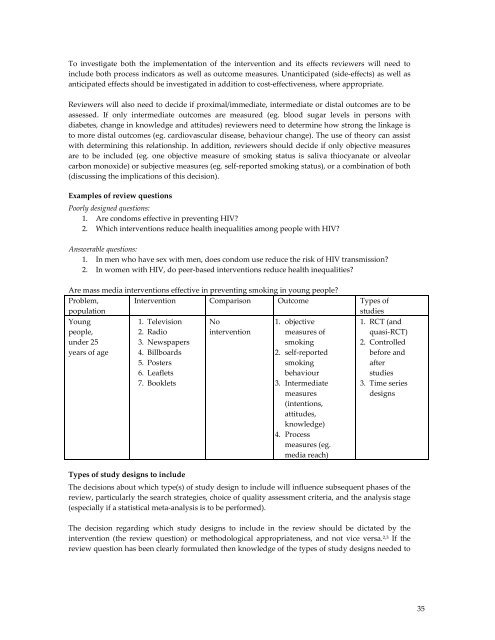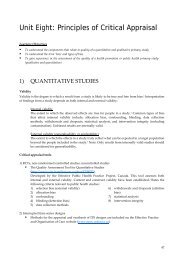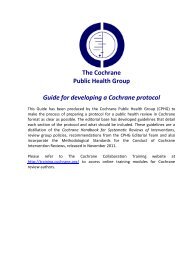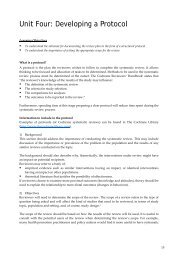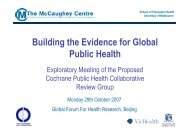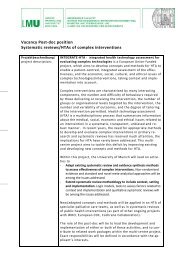Train the Trainer Course book - Cochrane Public Health Group
Train the Trainer Course book - Cochrane Public Health Group
Train the Trainer Course book - Cochrane Public Health Group
You also want an ePaper? Increase the reach of your titles
YUMPU automatically turns print PDFs into web optimized ePapers that Google loves.
To investigate both <strong>the</strong> implementation of <strong>the</strong> intervention and its effects reviewers will need to<br />
include both process indicators as well as outcome measures. Unanticipated (side-effects) as well as<br />
anticipated effects should be investigated in addition to cost-effectiveness, where appropriate.<br />
Reviewers will also need to decide if proximal/immediate, intermediate or distal outcomes are to be<br />
assessed. If only intermediate outcomes are measured (eg. blood sugar levels in persons with<br />
diabetes, change in knowledge and attitudes) reviewers need to determine how strong <strong>the</strong> linkage is<br />
to more distal outcomes (eg. cardiovascular disease, behaviour change). The use of <strong>the</strong>ory can assist<br />
with determining this relationship. In addition, reviewers should decide if only objective measures<br />
are to be included (eg. one objective measure of smoking status is saliva thiocyanate or alveolar<br />
carbon monoxide) or subjective measures (eg. self-reported smoking status), or a combination of both<br />
(discussing <strong>the</strong> implications of this decision).<br />
Examples of review questions<br />
Poorly designed questions:<br />
1. Are condoms effective in preventing HIV?<br />
2. Which interventions reduce health inequalities among people with HIV?<br />
Answerable questions:<br />
1. In men who have sex with men, does condom use reduce <strong>the</strong> risk of HIV transmission?<br />
2. In women with HIV, do peer-based interventions reduce health inequalities?<br />
Are mass media interventions effective in preventing smoking in young people?<br />
Problem,<br />
population<br />
Intervention Comparison Outcome Types of<br />
studies<br />
Young<br />
people,<br />
under 25<br />
years of age<br />
1. Television<br />
2. Radio<br />
3. Newspapers<br />
4. Billboards<br />
5. Posters<br />
6. Leaflets<br />
7. Booklets<br />
Types of study designs to include<br />
No<br />
intervention<br />
1. objective<br />
measures of<br />
smoking<br />
2. self-reported<br />
smoking<br />
behaviour<br />
3. Intermediate<br />
measures<br />
(intentions,<br />
attitudes,<br />
knowledge)<br />
4. Process<br />
measures (eg.<br />
media reach)<br />
1. RCT (and<br />
quasi-RCT)<br />
2. Controlled<br />
before and<br />
after<br />
studies<br />
3. Time series<br />
designs<br />
The decisions about which type(s) of study design to include will influence subsequent phases of <strong>the</strong><br />
review, particularly <strong>the</strong> search strategies, choice of quality assessment criteria, and <strong>the</strong> analysis stage<br />
(especially if a statistical meta-analysis is to be performed).<br />
The decision regarding which study designs to include in <strong>the</strong> review should be dictated by <strong>the</strong><br />
intervention (<strong>the</strong> review question) or methodological appropriateness, and not vice versa. 2,3 If <strong>the</strong><br />
review question has been clearly formulated <strong>the</strong>n knowledge of <strong>the</strong> types of study designs needed to<br />
35


